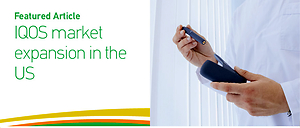COMMENTARY
IQOS, Philip Morris International’s (PMI) heated tobacco product, is currently sold in over 60 countries with over 17 million users and has the largest market share globally among heated tobacco products1,2. IQOS (priced at US$80–130) is marketed as a high-end alternative to cigarettes3. The IQOS device is used with HeatSticks, (also known as HEETS in some markets outside the US), which are IQOS specific short cigarettes that are inserted into the IQOS device for heating. Both IQOS and HeatSticks are sold in IQOS specialty stores, mall kiosks (Figure 1), temporary ‘pop-up’ stores, and non-specialty retail outlets (e.g. pharmacies, grocery stores, and convenience stores)4. Services offered in specialty stores and some retail outlets include general sales and returns, customer support, as well as trials of the IQOS device and the HeatSticks4. While IQOS marketing targets current smokers1, evidence indicates that it is also reaching non-smokers5.
Figure 1
IQOS kiosk at Tysons Corner Center in Tysons, Virginia on 22 May 2021, one of 21 IQOS stores within 25 miles of the 2000 zip code

In the US, PMI licensed IQOS to Altria for US sales and distribution, and sales began in September 2019 in Atlanta, Georgia, after authorization from the Food and Drug Administration (FDA)6. In July 2020, the FDA authorized that IQOS could be marketed as a ‘reduced exposure’ product (but denied the request to use ‘reduced risk’ in marketing, a broader health claim)7. In the US, awareness and use of IQOS is low but growing (particularly among current smokers, men, and racial/ethnic minorities)8,9. As of 17 May 2021, IQOS had expanded beyond Atlanta, GA, to the following additional markets: Buford, Georgia; Richmond and Tysons, Virginia; North Charlotte and Raleigh, North Carolina; and Charleston and Myrtle Beach, South Carolina10. At that time, IQOS had 52 specialty stores (including stand-alone stores, kiosks, pop-up stores) and 400 non-specialty retail outlets in the US (see Supplementary file for list of IQOS stores and outlets by market)10. The online store was not yet available, although the IQOS website indicated that it was ‘coming soon’ and same-day delivery was available in some local markets10. On 29 November 2021, imports and sales of IQOS were halted in the US when the US International Trade Commission ruled that the IQOS device infringed on the patent rights of a rival tobacco company11. PMI has faced similar patent suits in other countries and won (e.g. Greece and UK), and it is expected by industry observers that PMI will sue to overturn the court ruling in the US and resume its US sales in the near future11,12. Philip Morris has also indicated its intention to return to US markets. In addition to legal approaches, this could occur by PMI altering the device so that it no longer infringes on disputed patents12.
As PMI is likely to expand IQOS distribution in the US following the hiatus related to the patent dispute, as well as continue its global expansion1, consideration is currently needed to plan for monitoring of its sales and marketing. Surveillance systems will be needed to inform local and national regulatory efforts and keep pace with expansion efforts. Based on past marketing of tobacco products13, factors contributing to expansion decisions are likely influenced by three categories of factors: 1) general market factors such as larger population/market size and higher median household income13,14; 2) specific IQOS target market factors such as higher consumer spending and smoker culture and prevalence1,3,14; and 3) more lenient tobacco control context (e.g. cigarette excise taxes, smoke-free policies, state cessation/prevention funding)15. Table 1 provides an overview of the initial three markets in the US (Atlanta, Richmond, Charlotte) across these dimensions and provides related data regarding other potential markets. Based on these metrics, potential markets include those in states that make up ‘Tobacco Nation’ (i.e. Alabama, Arkansas, Indiana, Kentucky, Louisiana, Michigan, Mississippi, Missouri, Ohio, Oklahoma, Tennessee, West Virginia), where smoking prevalence is high and tobacco control is lenient14,15. Markets within these states are likely to be those with sufficiently large metropolitan areas with at least average or higher than average consumer spending such as Nashville, Tennessee, St. Louis, Missouri and Louisville, Kentucky15.
Table 1
Characteristics of initial launch sites and potential markets
| Atlanta, GA (Estimates) | Richmond, VA (Estimates) | Charlotte, NC (Estimates) | Other potential markets Large/medium-sized metro areas in the following states | ||||
|---|---|---|---|---|---|---|---|
| Populationa | 5803000 | 232866 | 2054000 | ||||
| Median household incomeb (US Median: $63179) | $60000 | $47000 | $53000 | ||||
| Total personal consumption expenditures by state (in millions)c | $404263.7 | $397230.5 | $389094.9 | California (1st), Texas (2nd), New York (3rd), Florida (4th), Pennsylvania (5th), Illinois (6th), Ohio (7th), New Jersey (8th), Michigan (9th), Georgia (10th), Virginia (11th), North Carolina (12th) | |||
| Prevalence | Rank | Prevalence | Rank | Prevalence | Rank | ||
| State adult smoking prevalenceb | 16.3% | 28th | 14.0% | 12th | 18.5% | 38th | West Virginia (50th), Kentucky(49th), Louisiana (48th), Ohio (47th), Mississippi (46th), Alabama (45th), Arkansas (44th), Tennessee (43rd), Missouri (42nd), Indiana (41st) |
| State youth smoking prevalenceb | 4.0% | 7th | 5.5% | 25th | 8.3% | 40th | Wyoming (51st), West Virginia (50th), South Dakota (49th), Arkansas (48th), Minnesota (47th), Oklahoma (46th), New Mexico (44th), Kentucky (44th), Louisiana (42nd), Alaska (42nd) |
| Grade; Score | Rank | Grade; Score | Rank | Grade; Score | Rank | ||
| State smoke-free airb | C; 29 | 40th | F; 18 | 43rd | F; 22 | 41st | Kentucky (50th), West Virginia (49th), Texas (48th), South Carolina (47th), Mississippi (46th), Alabama (45th), Missouri (44th), Virginia (43rd), Alaska (42nd), North Carolina (41st) |
| Prevention and cessation fundingb | F; 3.0% | 50th | F; 12% | 32nd | F; 5.4% | 46th | Georgia (50th), Missouri (50th), Texas (49th), New Jersey (48th), Michigan (47th), North Carolina (46th), Washington (44th), Nevada (45th), Connecticut (43rd), Alabama (42nd) |
| Cigarette tax (per pack)b | F; 13 | 45th | F; 12 | 46th | F; 16 | 37th | Alabama (51st), South Carolina (50th), Nebraska (46th), North Dakota (46th), Tennessee (46th), Virginia (46th), Georgia (45th), Kentucky (44th), Texas (43rd) |
c https://apps.bea.gov/iTable/iTable.cfm?reqid=70&step=1&acrdn=7#reqid=70&step=1&acrdn=7">https://apps.bea.gov/iTable/iTable.cfm?reqid=70&step=1&acrdn=7#reqid=70&step=1&acrdn=7. Rank refers to number on list from 1 to 51 (all states and DC) with 1 being bestand 51 being the worst.
CONCLUSION
Public health surveillance efforts are needed in the US and globally to monitor the expansion of heated tobacco products such as IQOS (e.g. new markets, online direct-to-consumer sales), marketing activities (e.g. advertisements, direct marketing, point-of-sale promotions, product trials, social media marketing on Facebook and Instagram), and product awareness and use, especially given the disproportionate impact of such products among youth. Surveillance could entail standard methods (e.g. surveys, point-of-sale audits), as well as novel methods including online listening tools such as Tobacco Watcher (https://tobaccowatcher.globaltobaccocontrol.org/), Google Trends, and CrowdTangle for Academics and Researchers for social media monitoring16. As online stores are country specific, tools like CyberGhost can be used to visit IQOS online stores globally to understand regional differences in online sales and marketing strategies. These online tools allow researchers and practitioners to create interactive dashboards and alerts to understand: 1) public perception of IQOS; 2) marketing impacts in nearreal time and by geographical region; and 3) tobacco company use of global online platforms (e.g. online stores, social media) to circumvent regulatory policy. Such surveillance can help targeted jurisdictions to prepare regulatory action and inform future local, state and federal regulatory efforts in the US, as well as globally.


